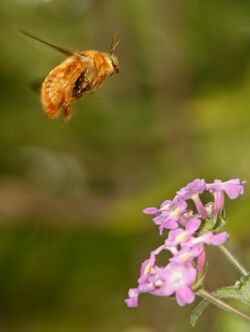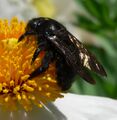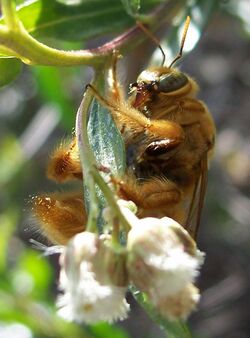Biology:Xylocopa varipuncta
| Valley carpenter bee | |
|---|---|

| |
| Male Xylocopa varipuncta | |
| Scientific classification Error creating thumbnail: Unable to save thumbnail to destination
| |
| Domain: | Eukaryota |
| Kingdom: | Animalia |
| Phylum: | Arthropoda |
| Class: | Insecta |
| Order: | Hymenoptera |
| Family: | Apidae |
| Genus: | Xylocopa |
| Species: | X. varipuncta
|
| Binomial name | |
| Xylocopa varipuncta Patton, 1879
| |
Xylocopa varipuncta, the valley carpenter bee, is a species of carpenter bee found from western Texas to northern California.[1] Females are black while males are golden-brown with green eyes. They are among the largest bees found in California,[2] growing to around 1 inch (2.5 cm) in length.
An unusual characteristic of X. varipuncta is their ability to thermoregulate at temperatures beyond the range of other bee species that have been tested; they can fly at very high temperatures without overheating and at low temperatures without freezing.[3] By modifying their foraging patterns and flying between different altitudes depending upon temperature, the valley carpenter bee is able to adapt to very different environments.[3]
Taxonomy
X. varipuncta is one of three southwestern US species in the genus Xylocopa, which has 31 subgenera and 500 species worldwide.[4]
Description and identification
X. varipuncta are 2.5 cm (1 inch) in length and are among the largest bees found in California. Compared to bumblebees, X. varipuncta have a more shining abdomen.
Like most native bees, females are not aggressive, and will normally sting only when provoked[5], while the males do not have stingers. Males possess a large thoracic gland that produce pheromones to attract females.
A pollen-covered female on a Passionflower
Distribution and habitat
This species is found in the southwestern part of the United States (Arizona, California, New Mexico, Nevada, Texas, and Utah) and adjacent parts of Mexico. The primary habitats of X. varipuncta are valleys and foothills with deciduous trees dominated by oaks.[6]
Life cycle
In the spring, females mate with males and then may disperse and start new nests, or clean out and enlarge the old tunnels used during the winter, adding brood cells. Each cell a female provisions contains a substance called "bee bread", which is a mixture of pollen and nectar used as food for the larvae. An egg is deposited on the pollen mass and each cell is sealed off with a partition of sawdust. Young adult male and female bees hibernate in the tunnels during the winter.
Behavior
Female behavior
Virgin females may make exploratory foraging flights and be attracted to visual and olfactory signals. Female mate-searching behavior might involve waiting for the male at the flower on which she discovers his markings or a directed flight toward a marked spot from a distance.[7]
Nesting
All nesting cycles for all species of Xylocopa show common features.[7] The bees have a period of reproductive dormancy even in the presence of the other sex that occurs during the dry seasons.[7] Or, they may enter into a non-reproductive phase during the cooler months.[7] The second characteristic of nesting cycles is that the dormant females are unmated.[7] Additionally, mating occurs after territorial flights by the males and before nest establishment.
The name "carpenter" comes from the fact that these bees excavate nests inside a variety of woods,[8] and the species' common name refers to the Californian Central Valley in which they are commonly found. Like its close relative, Xylocopa virginica, X. varipuncta like to nest in fence posts, telephone poles. and structural timbers. The bees will tunnel through wood with their mandibles, although they do not ingest the wood in the process, and they avoid painted or stained wood. The tunnels average 6 to 10 in (15 to 25 cm) in length and consist of a linear series of partitioned brood cells.[2][5] The adult bees spend the winter in the tunnels. Most nests of X. varipuncta contain a single female and her brood.[6][8][2][9][5]
Because Xylocopa species are not aggressive, defense is primarily carried out by building well constructed cell partitions, blocking the nest entrance in various ways, covering the cell partitions with liquid substances, or sacrificing all the brood of a nest that has been compromised by a parasite.[7]
Pollination
Flowers are the sole source of food and water for these bees, which have a pattern of visiting certain plants at various times throughout the day, and provide pollen for the females to feed their brood.[8] To collect pollen from most flowers, females gather pollen on their hindlegs through contact with the exposed anthers, but in flowers such as Solanaceae with closed anthers, they can use buzz pollination, by which the pollen is released from anther following vibration of the indirect flight muscles of the bee.[7]
Even though these bees are good pollinators, when visiting flowers that are so deep they cannot reach the nectar with their tonques, they engage in "nectar theft" or "robbery", cutting into the corolla tubes and imbibing the nectar through a slit, stealing the nectar without pollinating.[7]
Some flowers protect themselves from robbery with adaptive structures such as strong plant walls or by producing extrafloral nectar which is visited by ants that inhibit the bees from robbing the nectar, though ant guards are only effective against certain bee species (not Xylocopa).[7]
Male behavior
Males of X. varipuncta appear to optimize their mate-locating activity, following the predictions of the ideal free distribution theory.[10] This theory states that the most fit individuals will seek to occupy the most resource rich territory and those that are less fit will have to occupy a resource lacking territory until both territories are filled.[10] For species such as X. varipuncta, there are patches of different quality arising from "the continuous but variable input of mate-searching females over afternoons and flight seasons".[10] Males may rely on environmental cues rather than on food availability when choosing their territories.[7]
Attractive pheromone
The large mesosomal gland of male X. varipuncta produces volatile components, called pheromones, which are attractive to females.[11] These pheromones are long-range attractants and are used as male advertisements.[11] The gland is seasonally active and overwintering males have no detectable attractant.[11] X. varipuncta mark the central area of their territories with the pheromones.[11] Three observations were made that helped form this conclusion:
- Flying bees occasionally brush against leaves or twigs towards the center
- The "land and walk" behavior occurs at the focal area involving the application of the pheromone chemical
- Females fly to and pause on non-flowering plants that had been the focal area of the male where the attractant was placed.[11]
Teritoriality and site fidelity
Non-resource-based territoriality evolved from food source territoriality as a response to a low density of bees.[7] The probability of a single male encountering females is very low, and the production of attractants by the male would be advantageous to both sexes.[7] The attractants may be signals such as loud buzzing by the male and the addition of an odor to the flowers. The males may use these signals when patrolling along extended paths or hovering at a specific site. "At this point real male dominance polygyny begins, for males may produce quantitatively or qualitatively individual pheromonal signals that may reflect their fitness, and the female could react correspondingly by selecting among the males".[7] The use of pheromonal signals allows males to relocate their territories from resource sites to prominent sites such as hilltops, various protrusions, or trees. At this point, pheromones may direct the female into the territory founded by males. Short-range marking of the signal by the female bee attracts them to male territory just before copulation will occur.[7] Competition among males for non resource sites may lead to adaptations that continue to evolve until one male has an advantage over the other.[7]
There are various factors that affect X. varipuncta fidelity rates.[12] First, high mortality rates of resident males is significantly correlated with frequent turnover rates and decreased site fidelity.[12] Second, male density affects site fidelity. As the ratio of rivals to suitable territories rises, competition for territorial control increases, which leads to frequent turnover. In contrast, if there are few replacements for territory owners, there will be evidence of increasing site fidelity.[12] For X. varipuncta, the prevalence of days of very low territorial occupation and a few days of high male density in "lek" conditions resulted in decreasing fidelity.[12] Another aspect of the environment that affects site fidelity is the quality of territorial sites. Finally, fluctuating or declining territory value should reduce the extent of site fidelity. The extent to which female territorial preferences remain constant throughout the mating season will be very important in territory value. Males are expected to abandon territories at times when they no longer have the potential to produce offspring.[12] It is also conceivable that in X. varipuncta, the quality of the male's sex pheromone may be a key feature determining his sexual attractiveness. Most males of X. varipuncta did not exhibit site fidelity, while few males exhibited strong attachment to their original sites.[12]
Thermoregulation
Xylocopa varipuncta maintain thoracic temperatures of 33.0 to 46.5°C while traveling through environments with 12.0 to 40.0°C.[3] Since the thoracic temperature is not constant the bees are thermoregulating. There is physiological transfer of large amounts of heat to the abdomen and to the head during pre-flight warming and thoracic heating.[3] The temperature increase of the head is due to passive conduction, while the abdomen is due to physiological heat transfer throughout the body.[3] Xylocopa have circulatory anatomy like honeybees and bumblebees. Like bumblebees, they have an aortic loop through the flight muscles that acts as a cooling coil allowing heat transfer to the blood, head, and abdomen.[3]
Carpenter bees have large heads, which present a larger surface area for convective cooling.[3] The abdomen is also "well-suited for rapid convective heat loss because it is flattened dorso-ventral, and uninsulated". Physiological heat transfer to head or abdomen would not be apparent from body temperatures due to the rapid convective cooling, especially at high air temperatures when flight speed increases; thermoregulation involves a strong reliance on forced convection as a result of changes in flight speed, with active heat transfer to the abdomen and evaporative heat loss from the head at high temperatures.[3]
References
- ↑ Waller, Gordon D.; Vaissiere, Bernard E.; Moffett, Joseph O.; Martin, Joseph H. (1985-06-01). "Comparison of Carpenter Bees (Xylocopa varipuncta Patton) (Hymenoptera: Anthophoridae) and Honey Bees (Apis mellifera L.) (Hymenoptera: Apidae) as Pollinators of Male-sterile Cotton in Cages". Journal of Economic Entomology 78 (3): 558–561. doi:10.1093/jee/78.3.558. ISSN 0022-0493. http://jee.oxfordjournals.org/content/78/3/558.
- ↑ 2.0 2.1 2.2 Powell, Jerry A.; Charles L. Hogue (1980-09-08). California Insects. California: University of California Press. p. 398. ISBN 978-0-520-03782-3.
- ↑ 3.0 3.1 3.2 3.3 3.4 3.5 3.6 3.7 Heinrich, Bernd; Buchmann, Stephen L. (1986-07-01). "Thermoregulatory physiology of the carpenter bee, Xylocopa varipuncta". Journal of Comparative Physiology B 156 (4): 557–562. doi:10.1007/BF00691042. ISSN 0174-1578.
- ↑ Leys, Remko; Cooper, Steve (December 2000). "Molecular Phylogeny of the Large Carpenter Bees, Genus Xylocopa (Hymenoptera: Apidae), Based on Mitochondrial DNA Sequences". Molecular Phylogenetics and Evolution 17 (3): 407–418. doi:10.1006/mpev.2000.0851. PMID 11133195.
- ↑ 5.0 5.1 5.2 "UC Davis Department of Entomology – News: Ferocious-Looking, Green-Eyed Buzzing Insects Are 'Teddy Bears'". Entomology.ucdavis.edu. 2009-01-26. Archived from the original on February 20, 2010. https://web.archive.org/web/20100220194551/http://entomology.ucdavis.edu/news/valleycarpenterbees.html. Retrieved 2009-07-05.
- ↑ 6.0 6.1 Tuleyome, Compiled by Mary K. Hanson for (2015-08-05). A Species Guide for the Berryessa Snow Mountain Region. Lulu.com. ISBN 9781312746398. https://books.google.com/books?id=xCzNCQAAQBAJ.
- ↑ 7.00 7.01 7.02 7.03 7.04 7.05 7.06 7.07 7.08 7.09 7.10 7.11 7.12 7.13 7.14 Gerling, D. (1989). "Bionomics of the Large Carpenter Bees of the Genus Xylocopa". Annual Review of Entomology 34: 163–190. doi:10.1146/annurev.ento.34.1.163. http://www.tau.ac.il/lifesci/departments/zoology/members/gerling/documents/reviews2.pdf. Retrieved October 11, 2015.
- ↑ 8.0 8.1 8.2 "Carpenter Bees". http://www.fs.fed.us/wildflowers/pollinators/pollinator-of-the-month/carpenter_bees.shtml. Retrieved 2015-10-07.
- ↑ "Valley Carpenter Bee, Xylocopa varipuncta". Nathistoc.bio.uci.edu. 2006-12-08. http://nathistoc.bio.uci.edu/hymenopt/Xylocopa.htm. Retrieved 2009-07-05.
- ↑ 10.0 10.1 10.2 Alcock, John (1996-03-01). "Timing of mate-locating by males in relation to female activity in the carpenter bee Xylocopa varipuncta (Hymenoptera: Apidae)". Journal of Insect Behavior 9 (2): 321–328. doi:10.1007/BF02213874. ISSN 0892-7553.
- ↑ 11.0 11.1 11.2 11.3 11.4 Minckley, R.L. (1991). "Bioassay evidence for a sex attractant pheromone in the large carpenter bee, Xylocopa varipuncta". Journal of Zoology 224 (2): 285–291. doi:10.1111/j.1469-7998.1991.tb04805.x.
- ↑ 12.0 12.1 12.2 12.3 12.4 12.5 Alcock, John (1993). "Differences in Site Fidelity Among Territorial Males of the Carpenter Bee Xylocopa varipuncta (Hymenoptera: Anthophoridae)". Behavior 125 (3/4): 199–217. doi:10.1163/156853993x00245.
Wikidata ☰ Q1926971 entry
| Wikimedia Commons has media related to Xylocopa varipuncta. |






